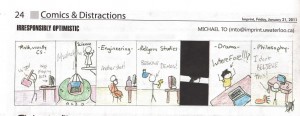The manuscript for the journal paper that I co-authored has been accepted for Software: Practice and Experience. The paper is titled DataMill: A Distributed Heterogeneous Infrastructure for Robust Experimentation and describes the second version of DataMill, a performance evaluation infrastructure, that I helped to build.
When I finished my undergrad degree, I regretted taking CS 467. I spent about 80% of my coursework time on that class. Now that I see the same notation and set theory used in a statistics textbook I am reading, I would say the course was totally worth it. It would have helped if I had taken the assignments lightly, since the assignment questions were always a puzzle to students. The time would have been better spent working through examples in the textbook. Looking back at my elective courses, I am glad I didn’t take a CS elective that was mostly programming, such as CS 349. Classes like CS 360 enhance math skills which are helpful in graduate studies.
At the exam today Professor Mosca wore a suite again. He does that too often teaching the class. Maybe he wants us to take graduate courses in the field. He talks about the classes every time a relevant lecture topic comes up.
Compared to other classes I took this term, I learned the most from this one. I read the first few chapters of the textbook before the class, but got bogged down by the notation. Taking the class and working on the assignments helped me to learn it. The slides had extra material to go along with the textbook.
Those walks in the QNC building were memorable. The wooden stairs hanging in the air with light filtering through glass walls and white boards beside sofas capture the spirit of the building.
The solutions to homework assignments were always simple, but they’re challenging when going through the material for the first time. I spent many days this term working on them, long enough that I would have read How to Solve It at the start of the term. I plan to read that book as I start work next month, since the problems solving skills always help.
CS 467 is Introduction to Quantum Information Processing, which I have with Michele Mosca. He has received many awards and written the textbook with other authors for the course. However, he is a very approachable professor. He gives detailed answers to questions during lecture and stays after class to answer questions. He makes the subject more approachable pointing out areas that he had trouble with when he started in the field, making sure we are better prepared to read papers in the area. With people like him doing research and teaching students, quantum computing will be ubiquitous in 15 years and Waterloo will be heading the effort.
Besides wanting to take the course for a long time, the course also cleared up assumptions I had:
- What makes quantum theory able to accommodate Schrödinger’s cat is the probabilistic representation of qubits, which isn’t magical at all in mathematical terms.
- Information can only travel as fast as light, as in the case of quantum teleportation where classical bits are sent to transfer qubits
- Unmeasured quantum states can change simultaneously, as in entanglement
- The secret ingredient to quantum computation: only measure what you need to know. As in the case of error correction codes, only measure the error
The Engineering as a Profession question and answer sheet was made about 3 years ago. Last time I changed the URL to make it more relevant in searches. However, I was still surprised to see more answer submissions this time. Today, I added those answers and fixed character issues that appeared since I converted files to UTF-8.
It definitely makes answering those questions on the exam easier. I developed and used it myself, with the goal of spending minimal amount of time on it. Separate files stored questions from the PDF study guide and the answers from Word, which are combined using a simple PHP program.

Point of views:
Engineering – nothing special here. Engineers know enough of science and chemistry to build a computer if civilization was destroyed. A common pitfall is not being able to control their thoughts. They rely on drinking to get a good night’s sleep, maybe due to too much responsibility and stress. Many of them carry this behavior into work life. To illustrate, the Engineers at Google drink on the job.
Computer Science – these guys run into more trouble with their computers than anybody else. Hence, the hammer is well deserved. The cutting edge of technology is more often the bleeding edge. It hurts.
Scientific – acids are the way to recycle computers. The guy must be an evil genius to come up with this method.
Religious – Note: the screen is glowing red. Use some water to put out the fire?
Drama – watch some movies, eat, or sleep? Can’t decide which.
Philosophical – perhaps the most beautiful of all. Given a computer, philosopher might ask, what is real? Might I not be interacting with a computer program? Is my entire life a simulation? What parts of the mind is real? What am I? If the ego is all I am, is it not easily replicated?
When I try to include an image in my work report, I get the following latex error:
LaTeX Error: Cannot determine size of graphic (no BoundingBox)
Then the solution is to convert it to a PostScript file. I use ImageMagick to convert the image using the command
/> convert image.jpg image.eps
and it generates the image file for latex. The eps file is about 50x larger than the original. The question then is whether writing documents in latex actually saves space by reducing formatting.
